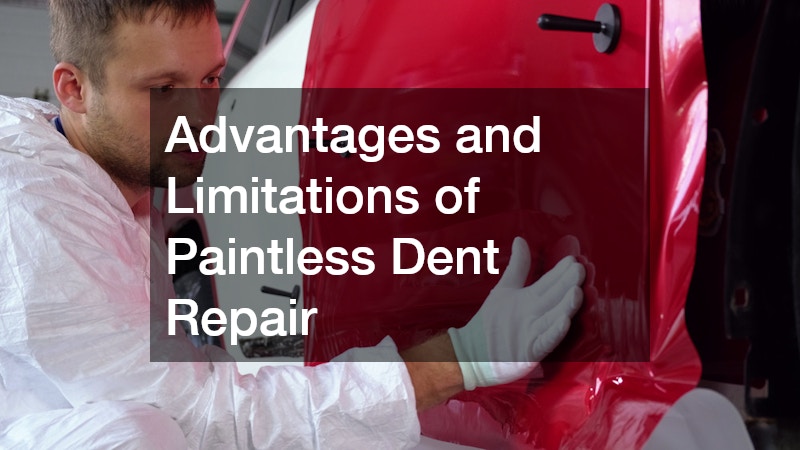Minor dents and dings to your vehicle can be an unavoidable part of car ownership, but they do not have to leave a lasting impact on its appearance. Fortunately, paintless dent repair (PDR) offers a cost-effective and efficient solution. If you’re curious about this innovative method, this article provides a detailed explanation of what to expect when you choose a paintless dent repair service.
The Basics of Paintless Dent Repair Service
When it comes to maintaining the pristine appearance of your vehicle, understanding the basics of paintless dent repair (PDR) is crucial. This technique is widely celebrated for its ability to fix dents without compromising the original paint of the car.
It involves the use of specialized tools to gently massage the dented area back to its original shape, making it an ideal solution for minor body damage. In contrast to conventional dent repair, PDR is cost-effective and significantly reduces the time your car spends in the shop. The process is typically completed within a few hours, depending on the severity of the dents.
The history of paintless dent repair dates back to World War II, when soldiers in Europe began using basic methods to repair dents on vehicles. While the process has evolved significantly since then, the core principle remains unchanged – remove the dent while retaining the integrity of the original paint job. This not just maintains the vehicle’s aesthetic appeal but also helps in preserving its resale value, a key benefit for car owners. In the world of auto repairs, maintaining the original paint is a notable advantage, as non-matching paint can devalue the vehicle.
One of the key inquiries car owners often have about PDR is whether it genuinely restores their vehicle’s look to its undamaged glory. The answer is overwhelmingly affirmative, assuming the dents aren’t exceptionally large or are located on areas that aren’t structurally supportive. Trained technicians can successfully revert paneled areas back to showroom condition without needing expensive paint or materials. In essence, paintless dent repair service provides precision and expertise with minimal invasion, making it a favored method among professional car detailers and enthusiasts.
The Step-by-Step Process of Paintless Dent Repair
The journey of repairing minor cosmetic damage via paintless dent repair service typically begins with a thorough assessment. Initially, the technician will inspect your vehicle to determine the location, size, and depth of the dent. This evaluation helps the technician decide whether PDR is suitable and plan the best course of action for repair. This inspection phase is crucial, as the success of paintless dent repair largely depends on the dent’s accessibility and the extent of the damage. Transparency during this stage can set realistic expectations and foster trust between the service provider and car owner.
Once the assessment is complete and PDR is deemed appropriate, the technician will proceed with preparing the car for repair. This may involve cleaning the area to ensure that no dirt or debris interferes with the process. Specialized tools such as metal rods and body picks are then employed to access and manipulate the dented region. Using finesse and precision, the technician massages the dent back to its original place, constantly evaluating their progress. This craftsmanship is what differentiates a quality paintless dent repair service from less professional approaches.
After the primary repair, the technician typically employs reflective tools to inspect the surface for any remaining imperfections. This step ensures that the surface of your car is even and true to form. Any minor discrepancies are meticulously adjusted, showcasing the painstaking attention to detail inherent in the PDR process. Finally, the area will be polished, returning your car’s finish to a showroom shine. This extensive sequence is what guarantees the high standards of PDR services, leaving your vehicle in immaculate condition.
Advantages and Limitations of Paintless Dent Repair
Paintless dent repair service offers numerous advantages that make it a popular choice among car owners and auto body specialists. One significant advantage is its cost-effectiveness compared to conventional dent repair methods. By eliminating the need for expensive materials like paint and fillers, PDR provides an affordable solution to dent issues. Additionally, the process is environmentally friendly, as it reduces the need for paint and chemical solvents, aligning with the global trend towards sustainable practices. These benefits make PDR a preferred choice for conscious consumers who seek effective and responsible auto repair options.
Despite its many advantages, PDR does have some limitations that potential users should be aware of. For instance, its effectiveness is contingent on the severity and location of the dent – extreme damage or creases may not be suitable for PDR. Similarly, areas close to the edge of a panel or with intricate metalwork might pose challenges that could require traditional methods. Understanding these limitations enables car owners to make informed decisions about the most appropriate repair process for their specific needs. By consulting with seasoned PDR specialists, you can determine the best approach for restoring your vehicle.



